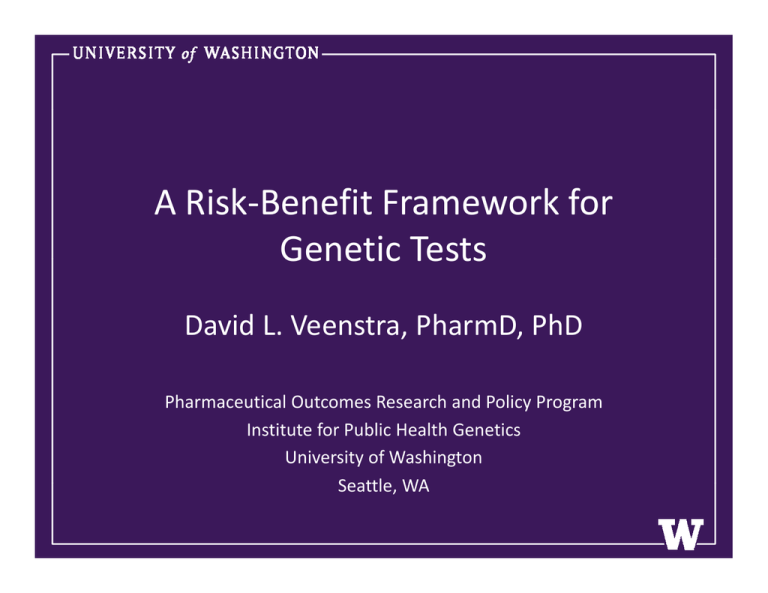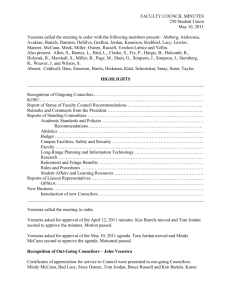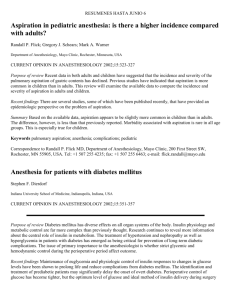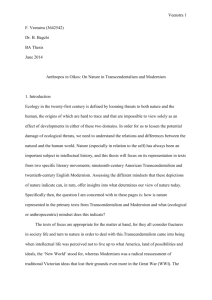A Risk‐Benefit Framework for Genetic Tests Genetic Tests David L. Veenstra, PharmD, PhD
advertisement

A Risk‐Benefit Framework for Genetic Tests Genetic Tests David L. Veenstra, PharmD, PhD David L. Veenstra, PharmD, PhD Pharmaceutical Outcomes Research and Policy Program y g Institute for Public Health Genetics University of Washington Seattle WA Seattle, WA G Genomics is Exceptional i i E ti l 1. 1 2. 3. 4. Ease and speed of market access Ease and speed of market access Evidence levels Volume of tests Costs dropping pp g – Just last year, genetic testing for warfarin therapy (3 SNPs) was available for $550. – Currently, available for $175 Currently available for $175 – Personal Genome Service® from 23andMe provides data on 580,000 SNPs for $999 $399. Veenstra 2 U l Unclear Evidence Requirements E id R i t • The The dichotomy of perspectives is exemplified by a recent Wall dichotomy of perspectives is exemplified by a recent Wall Street Journal article on the FDA’s decision to add pharmacogenomic information to the warfarin label: – "It would be irresponsible and potentially harmful to suggest that testing be used, or even mentioned, in the label," said University of Washington professor Ann Wittkowsky in an interview before the g p y FDA's decision. "It is fascinating science, but it is not yet ready for prime time." – LLarry Lesko, director of the clinical pharmacology office at the FDA, L k di f h li i l h l ffi h FDA says the agency has "substantial" evidence to support the new label and hopes it will improve safety by informing doctors. Veenstra 3 Translational Challenge of the Translational Challenge of the Genome‐Wide Era • How do we estimate the clinical risk‐benefit tradeoffs of genetic tests in a timely manner? tradeoffs of genetic tests in a timely manner? – To speed the development and use of beneficial tests – To avoid the use of tests that may lead to harm • Can we identify an evidence framework that y meets stakeholders’ needs? Veenstra 4 Ch ll Challenge of EBM f EBM • Traditional evidence‐based processes rely on direct evidence of clinical utility. • For example, as stated in a recent evidence report for g gene expression profiling in breast cancer: p p g “… clinical utility…can only be assessed in the context of randomized clinical trials” Veenstra 5 F Formal Risk‐Benefit Analysis (RBA) l Ri k B fit A l i (RBA) • Recent Recent interest in the use of formal risk‐ interest in the use of formal risk benefit analysis in regulatory decision making for drugs and biologics (IOM panel; ki f d d bi l i ( O l FDA consideration) Veenstra 6 Historical Timeline on Drug Safety g y “Crisis” – January 30, 2007—FDA announces 41 initiatives on drug safety in response to IOM report One FDA initiative: “Developing and incorporating new quantitative tools in the assessment of risk and benefit… ‐‐ June 2007—Avandia (rosiglitazone), diabetes drug controversy – November 2008 FDA‐PhRMA‐BIO Working Conference; Next Steps Working Group formed Veenstra 7 Veenstra 8 Obj ti Objective To help decision makers think more clearly To help decision makers think more clearly about the magnitude and uncertainty of the potential clinical benefits and harms of i l li i l b fi dh f genetic tests Veenstra 9 Components of Risk‐Benefit Components of Risk‐Benefit Framework: 1. Decision Modeling Veenstra 10 D ii A l i Decision Analysis • Systematic – Consider all available data – Evaluate alternative options Evaluate alternative options • Formal – Reproducible p – Transparent • Quantitative – Probabilities of events – Value of events – Uncertainty evaluated Veenstra 11 Decision Modeling for g Genetic Tests Veenstra 12 Components of Risk‐Benefit Components of Risk‐Benefit Framework: 2. Defining Clinical Utility Veenstra 13 Cli i l O t Clinical Outcomes • Benefit – Absolute risk reduction – NNT • Harm – Absolute risk increase – NNH • Clinical Utilityy – (Benefits) – (Harms) – Difference in (Quantity x Quality) of life Veenstra 14 Q lit Adj t d Lif Y Quality‐Adjusted Life‐Years (QALY) (QALY) • • • • A measure of overall clinical outcomes A measure of overall clinical outcomes QALY = life expectancy x quality of life (QoL) QoL estimated on a scale of 0 to 1 More specifically, health‐related QoL p y – physical functioning – social functioning social functioning – emotional functioning – mental mental functioning functioning Veenstra 15 Components of Risk‐Benefit Components of Risk‐Benefit Framework: 3. Decision Matrix Veenstra 16 Ri k B Risk‐Benefit Categorization Matrix fit C t i ti M t i Veenstra 17 Ch ll Challenges • USPSTF methods report USPSTF methods report “Although formal decision analyses … have been proposed as an objective method to weigh benefits and harms, … such analyses can be complex and opaque and may rely such analyses can be complex and opaque and … may rely on various assumptions, each of which may have substantial uncertainty.” Sawaya et al, Ann Int Med 2007 Veenstra 18 Example 1: W f i Ph Warfarin Pharmacogenomic i Testingg • Does use of genetic testing improve patient outcomes? • Decrease bleeding risk, Increase clotting risk? – Balance of benefit vs. risk – Net benefit • Level of evidence – Scientific and clinical plausibility? – Comparative data? – Definiti Definitive RCT? e RCT? Veenstra 19 Di t E id Direct Evidence: A Clinical Trial? A Cli i l T i l? • Identify a comparator and setting Identify a comparator and setting – Standard of care or clinical algorithm? • RCT measuring bleeds would be large RCT meas ring bleeds o ld be large – 5,000 – 10,000 patients would be required • NHLBI NHLBI‐sponsored RCT being initiated in ~2,000 d RCT b i i i i d i 2 000 patients, primarily in (academic) anticoagulation clinics li i – primary outcome: TTR in first month Veenstra 20 S h Schematic of Decision Model ti f D i i M d l Veenstra 21 RCT: Test vs No Test N=200 RCT: Test vs. No‐Test, N=200 Wild-types: yp time in-range Anderson et al, Circulation 2007 Meckley et al, CDC NOPHG 10th Anniv. 2008 VKOR O variants: a a s little change Veenstra CYP2C9 variants: trade-off 22 Warfarin Risk‐Benefit Analysis y Results • In a population of 10,000 people, testing would reduce the number of bleeds by 17, but increase the number of thromboembolic events by 3. • Life expectancy increased by 0.005 year • Quality‐adjusted life‐years (QALYs) increased by 0.004 (1‐2 days) Veenstra 23 U Uncertainty in Results t i t i R lt • Inputs varied using simulation techniques – Results of repeated simulations stored and p evaluated • Range of QALYs Range of QALYs – Increase of 0.02 (1 week) to decrease of 0.01 (3 days) y) Veenstra 24 Where Might We Put g Warfarin PGx? ? Veenstra 25 Example 2: p Tamoxifen and Breast Cancer Treatment • Tamoxifen Tamoxifen is widely used for the treatment and prevention of is widely used for the treatment and prevention of estrogen receptor (ER)‐positive breast cancer. • CYP2D6 is the major enzyme that ‘activates’ tamoxifen to j y endoxifen, the major contributor to tamoxifen’s anti‐ estrogenic effect. • Recent studies have found that women with CYP2D6 Recent studies have found that women with CYP2D6 poor poor metabolizer genotype may have higher cancer recurrence rates than women with no variant alleles. • Pharmacogenetic screening for CYP2D6 variants could be a useful approach to help clinicians identify women that would be be better candidates for alternative therapies. better candidates for alternative therapies Veenstra 26 FDA L b l Ch FDA Label Change? ? • On On October 18, 2006, an FDA Advisory October 18 2006 an FDA Advisory Subcommittee reviewed findings to date • The consensus was the label should be updated to The consensus was the label should be updated to reflect the fact that postmenopausal candidates for tamoxifen who are CYP2D6 poor metabolizers are at increased risk for breast cancer recurrence. • The FDA declined to act on the Advisory Committee's recommendation Veenstra 27 BCBS TEC A BCBS TEC Assessment t Veenstra 28 Q Quantitative Modeling tit ti M d li • Punglia et al developed 2‐state Markov model Punglia et al developed 2 state Markov model • Projected 5‐yr disease recurrence – 5‐year disease‐free survival of tamoxifen‐treated patients with no mutations (83.9%) that was similar to that for g genotypically unselected patients who were treated with yp y p aromatase inhibitors (84.0%). – With stronger genetic association estimates, disease‐free survival with tamoxifen exceeded that with aromatase inhibitors in wildtype/wildtype patients. Punglia, Weeks. JNCI 2008 Veenstra 29 T T t To Test… “We We believe that the current evidence is already believe that the current evidence is already strong enough to warrant an ethical obligation for physicians to inform their patients for physicians to inform their…patients about…CYP2D6 genetic testing” Gurwitz, Newman. JNCI 2008 Veenstra 30 …or Not to Test… N tt T t “Because Because of this uncertainty, and despite the of this uncertainty and despite the Punglia et al. model, we do not recommend routine CYP2D6 genotyping for all patients routine CYP2D6 genotyping for all patients who are considering tamoxifen” Hayes, Flockhart. JNCI 2008 Veenstra 31 …That Is the Question Th t I th Q ti “The The medical community is frequently torn medical community is frequently torn between the rapid acceptance of a new, exciting and potentially helpful strategy and exciting, and potentially helpful strategy and the possibility that after more extensive and careful investigation the risks associated with careful investigation, the risks associated with its use might not outweigh the benefits.” Hayes, Flockhart. JNCI 2008 Veenstra 32 Risk‐Benefit Analysis of CYP2D6 Testing and Tamoxifen Treatment Tamoxifen Treatment Veenstra 33 D t A Data, Assumptions ti • PM PM defined as people heterozygous or homozygous d fi d l h t h for variant allele *4 • HR for recurrence risk PM vs. EM: 1.91 (Goetz 2007) HR for recurrence risk PM vs EM: 1 91 (Goetz 2007) • No adjuvant tx. effect once patients are off 5‐yr therapy • Post‐tx relapse risk from EBCTG years 5‐15 • 2003 US mortality statistics 2003 US mortality statistics • Mean age 64yo (ATAC trial) Veenstra 34 M d l V lid ti Model Validation Veenstra 35 Results Table 1. treatment options by 2D6 testing QALY 2D6 testing no testing 2D6 testing overall 12.191 EM- rx: tamoxifen 12.211 PM- rx: anastrozole 12.147 tamoxifen 11.951 anastrozole 12.147 Veenstra 36 I Impact of PM/EM Recurrence Hazard Ratio t f PM/EM R H d R ti Veenstra 37 Where Does Tamoxifen Testing g Belong? ? Veenstra 38 Li it ti Limitations of Formal RBA fF l RBA • Stakeholder acceptance p – transparency – use of ‘QALY’ – uncertainty • Non‐clinical impacts challenging – ‘personal utility’ • willingness to pay • discrete choice experiments discrete choice experiments • Nuancing the ‘I’ recommendation – evidence development p – targeted use Veenstra 39 Summary • Assessing clinical utility of genetic tests is challenging • Lots of data, little information • Quantitative risk‐benefit assessment may be useful to inform policy decisions be useful to inform policy decisions Veenstra 40 A k Acknowledgements l d t • • University of Washington University of Washington – – – – – – – – – – Intermountain Healthcare – Marc Williams – Jim Gudgeon – Jeff Anderson Wylie Burke Scott Ramsey Lou Garrison Lou Garrison Rick Carlson Lisa Meckley Ann Wittkowsky Ann Wittkowsky Allan Rettie Mark Rieder Josh Carlson Josh Carlson Josh Roth • CDC – Scott Grosse – NOPHG Seed Fundingg – U18 GD000005‐01 (GAPP Initiative) Veenstra 41







